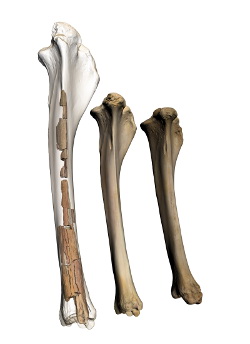Palaeoproteomics
‘Palaeoproteomics’ is the term used to describe the applications of proteomics (the analysis of sets of proteins) to ancient materials ranging from mineralised tissues such as bone and teeth to soft tissues that include hair and skin.

The field of proteomics was made possible with the advent of soft-ionization mass spectrometry methods in the late 1980s and early 1990s. The first application of this technology to ancient proteins was by Peggy Ostrom’s group in 2000 – the analysis of the small mineral-binding protein osteocalcin using Matrix Assisted Laser Desorption Ionization (MALDI) Mass Spectrometry.
Like other molecular techniques being used by palaeontologists at the time, this early research was primarily concerned with demonstrating the survival of proteins in fossil tissues. My own research interests focussed on the use of these ancient biomolecules not only for realising their potential for phylogenetic reconstructions, but as a tool for species identification of fragmentary, morphologically-unidentifiable material. After spending time learning to isolate the small mineral-binding protein osteocalcin by HPLC and SPE and analyse it using MALDI at the University of York (with Christina Nielsen-Marsh and Matthew Collins) and Michigan State University (with Peggy Ostrom) during my MSc and PhD, I demonstrated that these applications were of limited use due to the poor survival rates of OC compared to other more informative biomolecules. As part of this research I carried out proteome analyses of ancient bone (as well as heat-degraded meat and bone meal (MBM)) in order to understand the most useful proteins for further investigation.
Although contrary to some early studies suggesting the preferential survival of mineral-bound non-collagenous proteins, my early research showed that the dominant protein type 1 collagen remained the most abundant protein in ancient tissues, dating back at least one million years. However, this collagen protein was long considered a relatively uninformative molecule due to its repetitive Gly-Pro-Hyp motif throughout the molecule. My research has focussed on demonstrating that it is much more variable than previously recognised, to the extent that it can be used to separate taxa down the species level. Once we demonstrated that collagen peptide analysis could be used to distinguish sheep and goat (their skeletal remains are notoriously difficult to separate), the methods were rolled out to many other taxa; we called this application ‘Zooarchaeology by Mass Spectrometry’ or ZooMS for short.
Based in the Manchester Institute of Biotechnology, my research group carries out proteomics analyses as part of the Michael Barber Centre for Mass Spectrometry as well as the Faculty’s Core Biomolecular Analysis facility, giving us access to a wide range of soft-ionization mass spectrometers.



